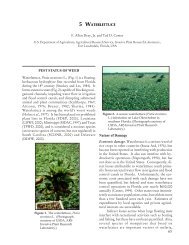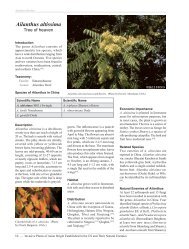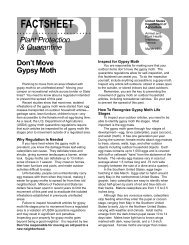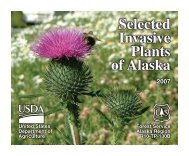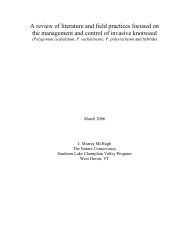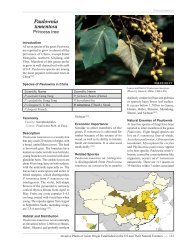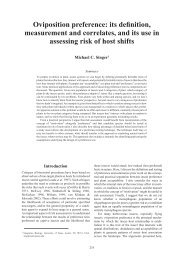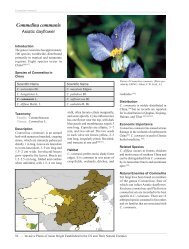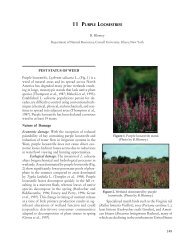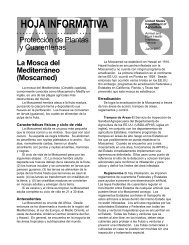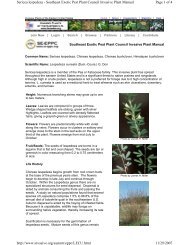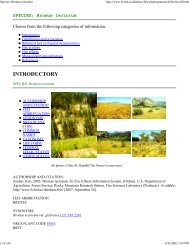A Guide to the Control and Management of Invasive Phragmites [PDF]
A Guide to the Control and Management of Invasive Phragmites [PDF]
A Guide to the Control and Management of Invasive Phragmites [PDF]
You also want an ePaper? Increase the reach of your titles
YUMPU automatically turns print PDFs into web optimized ePapers that Google loves.
underst<strong>and</strong>ing phragmites<br />
control methods<br />
recommended management strategies<br />
fur<strong>the</strong>r information<br />
part 1<br />
part 2<br />
part 3<br />
part 4<br />
3<br />
The Problem<br />
Once phragmites invades,<br />
it causes adverse ecological,<br />
economic <strong>and</strong> social<br />
impacts including:<br />
* Threats <strong>to</strong> coastal <strong>and</strong> interior<br />
wetl<strong>and</strong>s, which are Michigan’s<br />
most biologically diverse <strong>and</strong><br />
productive ecosystems.<br />
* Domination <strong>of</strong> native vegetation,<br />
displacing desirable native plant<br />
species such as sedges, rushes <strong>and</strong><br />
cattails, <strong>and</strong> reduction <strong>of</strong> plant<br />
diversity.<br />
* Reduction <strong>of</strong> wildlife habitat<br />
diversity resulting in loss <strong>of</strong><br />
food <strong>and</strong> shelter.<br />
* Alteration <strong>of</strong> water regime,<br />
causing “drying” <strong>of</strong> marsh soils<br />
through increased evaporation<br />
<strong>and</strong> trapping <strong>of</strong> sediments.<br />
* Reduction <strong>of</strong> property values<br />
due <strong>to</strong> use impairment.<br />
* Restriction <strong>of</strong> shoreline views<br />
due <strong>to</strong> tall, dense st<strong>and</strong>s.<br />
* Reduction <strong>of</strong> access for swimming,<br />
fishing <strong>and</strong> hunting.<br />
* Creation <strong>of</strong> potentially serious fire<br />
hazard <strong>to</strong> structures due <strong>to</strong> dry<br />
biomass during <strong>the</strong> dormant season.<br />
Underst<strong>and</strong>ing<br />
<strong>Phragmites</strong><br />
To better control <strong>and</strong> manage phragmites it is helpful <strong>to</strong> underst<strong>and</strong><br />
<strong>the</strong> physical characteristics <strong>of</strong> <strong>the</strong> plant, as well as how <strong>and</strong> when<br />
it reproduces <strong>and</strong> spreads.<br />
In Michigan, phragmites is found growing<br />
in coastal <strong>and</strong> interior marshes,<br />
bogs, fens, swamps, lake margins, roadside<br />
ditches <strong>and</strong> o<strong>the</strong>r low wet areas.<br />
Typically it prefers <strong>the</strong> wetl<strong>and</strong>-upl<strong>and</strong><br />
interface, though it can be found in dry<br />
upl<strong>and</strong>s.<br />
on page 2: Tall, dense st<strong>and</strong> <strong>of</strong> phragmites restricting views <strong>and</strong> access <strong>to</strong> water,<br />
<strong>and</strong> creating potential fire danger. J. Schafer<br />
<strong>Phragmites</strong> continues <strong>to</strong> exp<strong>and</strong> within<br />
Michigan, in part because it reproduces<br />
through wind dispersal <strong>of</strong> seeds <strong>and</strong> vigorous<br />
vegetative reproduction through<br />
rhizomes. Rhizomes broken by natural<br />
actions, such as waves, or man-made<br />
actions, such as dredging or disking,<br />
readily reroot in new locations. Rapid<br />
expansion also is facilitated by o<strong>the</strong>r disturbances<br />
that give phragmites a competitive<br />
edge, such as discharge <strong>of</strong> nutrients,<br />
wetl<strong>and</strong> drainage, fire <strong>and</strong> road salt.


![A Guide to the Control and Management of Invasive Phragmites [PDF]](https://img.yumpu.com/27321025/8/500x640/a-guide-to-the-control-and-management-of-invasive-phragmites-pdf.jpg)

